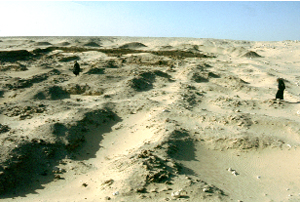
Geotimes Home | AGI Home | Information Services | Geoscience Education | Public Policy | Programs | Publications | Careers

 Eva Panagiotakopulu
went to the ancient city of Amarna, Egypt, to study how people lived 3,500 years
ago through fossilized insect remains. Unlike the nice clean city portrayed in
many reconstructions, the city, she discovered, was infested with bedbugs, fleas
and flies. And what she found in the insects was also a surprise: plague. On further
inspection, Panagiotakopulu began to think that perhaps the plague did not originate
in Central Asia, as has long been believed: Perhaps it began in Egypt.
Eva Panagiotakopulu
went to the ancient city of Amarna, Egypt, to study how people lived 3,500 years
ago through fossilized insect remains. Unlike the nice clean city portrayed in
many reconstructions, the city, she discovered, was infested with bedbugs, fleas
and flies. And what she found in the insects was also a surprise: plague. On further
inspection, Panagiotakopulu began to think that perhaps the plague did not originate
in Central Asia, as has long been believed: Perhaps it began in Egypt. |
Geotimes Home | AGI Home | Information Services | Geoscience Education | Public Policy | Programs | Publications | Careers |